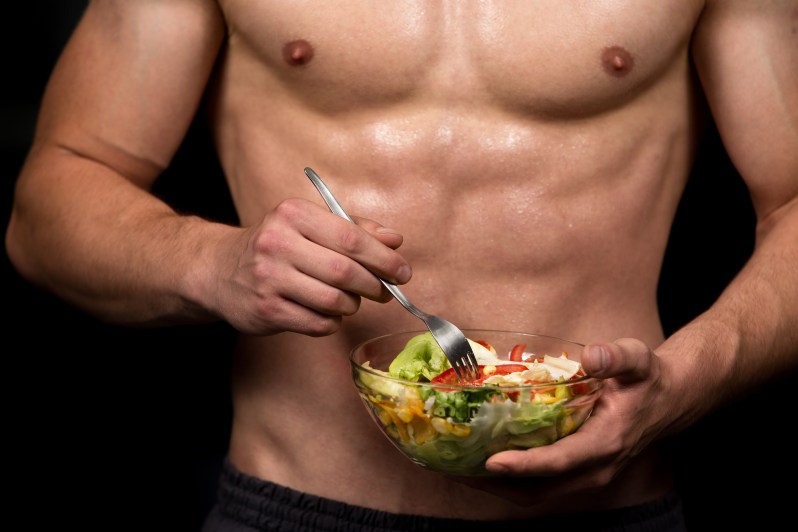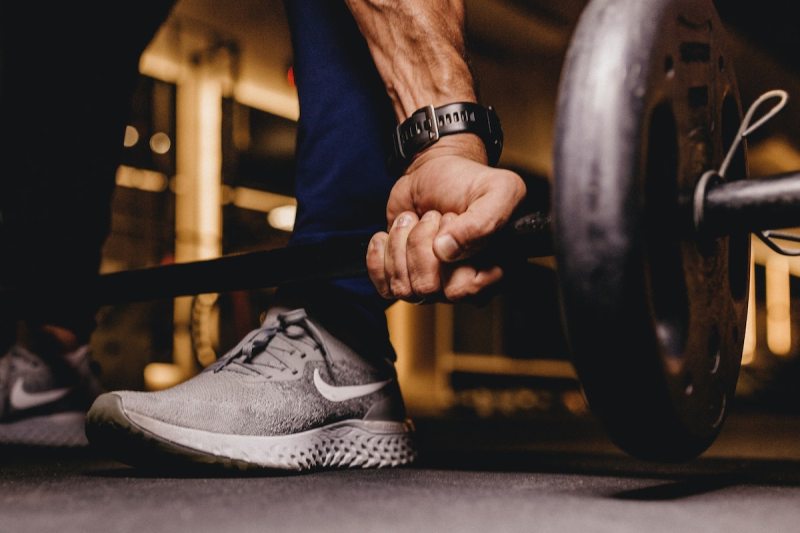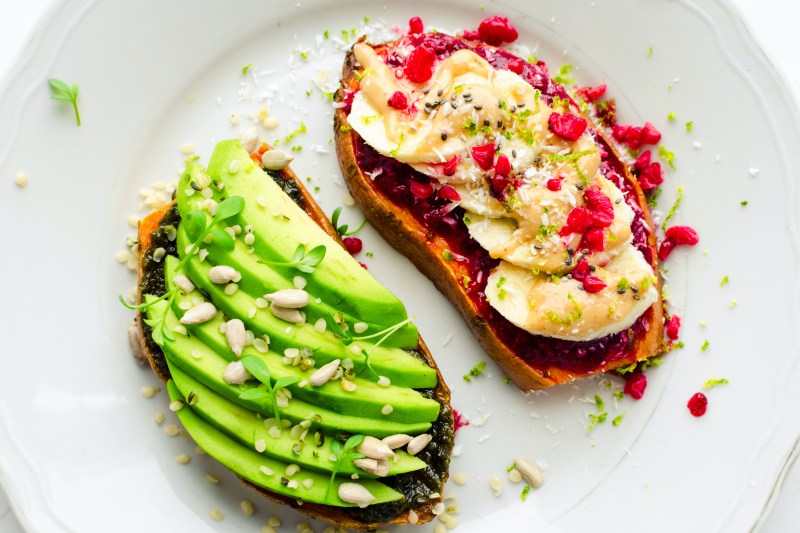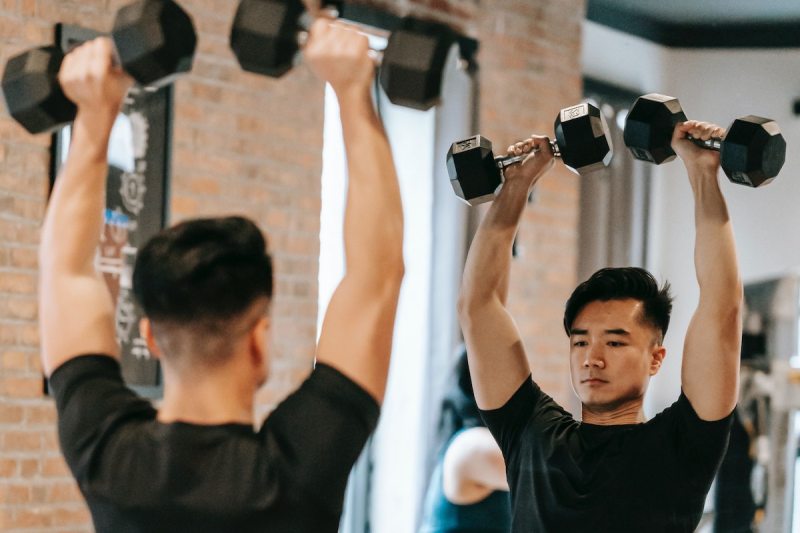
There are numerous reasons why someone may set out on a new workout program. A few of the most common fitness goals are to lose weight and build muscle; if you wish to do both, then you are likely pursuing body recomposition.
The details and structure of your workout plan will largely be dictated by your primary fitness goal. For example, if your goal is fat loss, your focus will be on burning calories and controlling your caloric intake to create the energy deficit necessary to burn fat. On the other hand, if your goal is to bulk up and build muscle mass, you will want to engage in strength training workouts that support hypertrophy (increases in muscle size) and up your nutrient intake to support muscle growth.
What happens if you want to do both simultaneously? Can you build muscle and lose fat at the same time? Keep reading to learn how to gain muscle while being in a caloric deficit so that you can bulk up and lose fat simultaneously.

What is body recomposition?
Increasing your lean body mass and decreasing your body fat are both body recomposition goals. Body composition refers to the relative percentage of fat tissue (adipose) and lean body mass (muscle, bone, organs, nerves, blood, connective tissues, etc.) you have. Body recomposition involves changing your body composition, usually by way of losing body fat and building muscle (lean body mass).

Can you add muscle while burning fat?
To lose body fat, you have to be in a caloric deficit, which means you’re consuming fewer calories than you’re burning on a regular basis. It takes a deficit of 3,500 calories to lose one pound of stored body fat. If you think about this over the course of a week, this equates to losing one pound of fat if you burn 500 more calories per day than you’re eating.
In order to promote muscle growth, also called hypertrophy, your muscles need both a stimulus and the necessary resources. The “stimulus” for muscle growth usually comes by way of strength training (lifting weights) with a workout program of progressive overload.
Heavy resistance training causes microscopic damage to your muscle fibers, essentially creating tiny tears in the muscle tissue. This damage stimulates the body to initiate the muscle reparative process. This process is called myofibrillar protein synthesis, but you’ll also sometimes hear it called muscle protein synthesis.
Here is where the “necessary resources” component of muscle growth comes into play.
The process of muscle protein synthesis requires adequate protein and energy (calories). Proteins from the foods you eat are broken down into their building blocks, called amino acids. These amino acids are shuttled to the muscle tissue after your workout and assembled into new reparative proteins.
This is an energy-heavy process, so if you’re not taking in an adequate number of calories or aren’t consuming enough proteins to provide the number of amino acids required to rebuild the muscle fibers, muscle protein synthesis will not occur or will be largely attenuated.
At this point, the conundrum might be clear: If you need to be in a caloric deficit to reduce body fat and you need to be in a caloric surplus to build muscle, how can you build muscle and lose fat at the same time?
Although most evidence suggests that you need to be in a caloric surplus to build muscle, there’s an important caveat. The body doesn’t necessarily experience the caloric deficit and caloric surplus on the rigid 24-hour clock we tend to think of when we think about weight loss. Instead, caloric balance is experienced on a minute-by-minute basis.
Basically, as soon as you eat something, your body goes into a state of relative caloric surplus because there’s an influx of energy and nutrients to use. This energy influx most likely exceeds what your body can possibly use in the brief amount of time it takes you to eat the food. When some time passes after you eat, your body experiences a state of relative caloric deficit.
This ongoing pattern continues throughout the day based on how many calories you’re eating and how often you eat. At the end of the day, you might be in a net caloric surplus because you consumed more calories than you burned, or you might be in a net caloric deficit because you burned more calories than you ate overall.
Because the body reacts to the caloric balance in a more immediate time based on resource availability, you can be strategic with the timing of your nutrition to help you build muscle and burn fat at the same time. For example, if you take in enough protein, carbohydrates, and calories right after your workout to support muscle protein synthesis but control your caloric intake later on in the day, it could be possible to accomplish both body recomposition goals simultaneously. Your results with each might be slower than if you were only focusing on one at a time, but at least you’ll be able to move the needle in both directions.

How should I eat to gain muscle and lose fat?
Evidence suggests that the most effective diet for muscle gain and fat loss in a caloric deficit is to consume 2.3 to 3.1 g/kg of lean body mass per day of protein, 15% to 30% of your total calories from fat, and the remainder of your calories from carbohydrates. It’s best to break up these nutrients into three to six meals per day. The meal right before and right after your resistance training workout should contain 0.4 to 0.5 g/kg (0.88 to 1.1 pounds) of body weight of protein. For example, if you weigh 75 kg (165 pounds), you should consume a minimum of 75 x 2.3g = 173g of protein per day and about 75 x 0.5 = 37.5g right after your workout.
Again, keep in mind that your rate of fat loss will be slower if you’re trying to build muscle at the same time. Research shows a rate that doesn’t exceed 0.7% of body fat per week. If you weigh 75 kg (165 pounds), this works out to 75 x 0.007, which is 0.525 kg or 1.2 pounds of fat loss per week.

How long does body recomposition take?
For many people who are fully focused and committed, body recomposition can take 8 to 12 weeks; however, it may take several months or even a year to achieve your desired results, because the time it takes depends on a number of factors, including:
- Starting point. If you’re overweight or obese, it will take longer to achieve body recomposition than if you are already at a healthy weight.
- Diet. As mentioned above, eating a calorie deficit is the key, which includes the right amount of protein and complex carbohydrates. Also, limit processed foods and sugary drinks.
- Exercise. A consistent strength training exercise routine is also essential for body recomposition. Aim for at least 30 minutes of moderate-intensity exercise most days of the week.
- Genetics. Some people are simply more genetically predisposed to building muscle and losing fat than others.
Ultimately, if you’re strategic with your diet and perform the right kinds of resistance training workouts with progressive overload, it’s possible to build muscle and lose fat at the same time.



